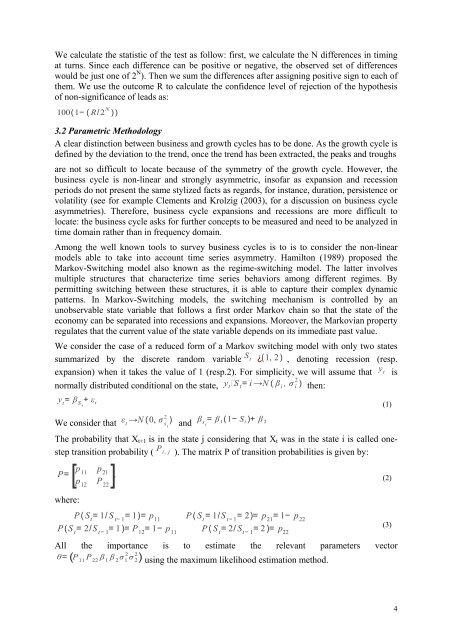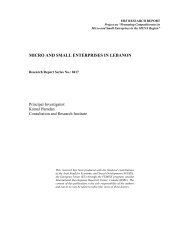business cycle leading indicators for the tunisian economy
business cycle leading indicators for the tunisian economy
business cycle leading indicators for the tunisian economy
Create successful ePaper yourself
Turn your PDF publications into a flip-book with our unique Google optimized e-Paper software.
We calculate <strong>the</strong> statistic of <strong>the</strong> test as follow: first, we calculate <strong>the</strong> N differences in timingat turns. Since each difference can be positive or negative, <strong>the</strong> observed set of differenceswould be just one of 2 N ). Then we sum <strong>the</strong> differences after assigning positive sign to each of<strong>the</strong>m. We use <strong>the</strong> outcome R to calculate <strong>the</strong> confidence level of rejection of <strong>the</strong> hypo<strong>the</strong>sisof non-significance of leads as:100(1− ( R/2 N ))3.2 Parametric MethodologyA clear distinction between <strong>business</strong> and growth <strong>cycle</strong>s has to be done. As <strong>the</strong> growth <strong>cycle</strong> isdefined by <strong>the</strong> deviation to <strong>the</strong> trend, once <strong>the</strong> trend has been extracted, <strong>the</strong> peaks and troughsare not so difficult to locate because of <strong>the</strong> symmetry of <strong>the</strong> growth <strong>cycle</strong>. However, <strong>the</strong><strong>business</strong> <strong>cycle</strong> is non-linear and strongly asymmetric, insofar as expansion and recessionperiods do not present <strong>the</strong> same stylized facts as regards, <strong>for</strong> instance, duration, persistence orvolatility (see <strong>for</strong> example Clements and Krolzig (2003), <strong>for</strong> a discussion on <strong>business</strong> <strong>cycle</strong>asymmetries). There<strong>for</strong>e, <strong>business</strong> <strong>cycle</strong> expansions and recessions are more difficult tolocate: <strong>the</strong> <strong>business</strong> <strong>cycle</strong> asks <strong>for</strong> fur<strong>the</strong>r concepts to be measured and need to be analyzed intime domain ra<strong>the</strong>r than in frequency domain.Among <strong>the</strong> well known tools to survey <strong>business</strong> <strong>cycle</strong>s is to is to consider <strong>the</strong> non-linearmodels able to take into account time series asymmetry. Hamilton (1989) proposed <strong>the</strong>Markov-Switching model also known as <strong>the</strong> regime-switching model. The latter involvesmultiple structures that characterize time series behaviors among different regimes. Bypermitting switching between <strong>the</strong>se structures, it is able to capture <strong>the</strong>ir complex dynamicpatterns. In Markov-Switching models, <strong>the</strong> switching mechanism is controlled by anunobservable state variable that follows a first order Markov chain so that <strong>the</strong> state of <strong>the</strong><strong>economy</strong> can be separated into recessions and expansions. Moreover, <strong>the</strong> Markovian propertyregulates that <strong>the</strong> current value of <strong>the</strong> state variable depends on its immediate past value.We consider <strong>the</strong> case of a reduced <strong>for</strong>m of a Markov switching model with only two statessummarized by <strong>the</strong> discrete random variable S t ¿(1, 2) , denoting recession (resp.expansion) when it takes <strong>the</strong> value of 1 (resp.2). For simplicity, we will assume that y t isnormally distributed conditional on <strong>the</strong> state, y t S t = i →N ( β i , σ 2 i ) <strong>the</strong>n:y t= β S t+ ε t(1)We consider that ε t →N (0, σ 2 s)t and β s = β 1 (1− S t )+ β 2tThe probability that X t+1 is in <strong>the</strong> state j considering that X t was in <strong>the</strong> state i is called onesteptransition probability ( P i,j ). The matrix P of transition probabilities is given by:P=[ p 11p 21p 12P 22] , (2)where:P ( S t= 1/ S t− 1= 1)= p 11P ( S t= 1/S t− 1= 2)= p 21= 1− p 22P (S t= 2/S t− 1= 1 )= P 12= 1− p 11P ( S t= 2/ S t− 1= 2 )= p 22(3)All <strong>the</strong> importance is to estimate <strong>the</strong> relevant parameters vectorθ= (P 11P 22β 1β 2σ 1 2 σ 22 ) using <strong>the</strong> maximum likelihood estimation method.4
















